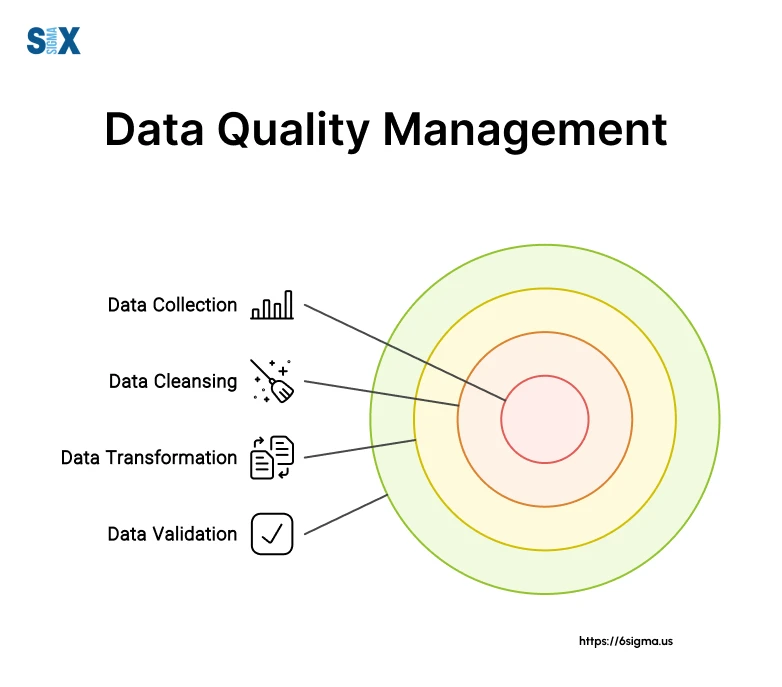A Complete Guide to Data Quality Management
Companies are dealing with massive growth in data amounts, types, and speed.
While this data flood offers a ton of potential for insights and fresh ways forward, it also brings serious issues around quality and reliability.
That’s where data quality management comes in — it’s a crucial process of putting standards, methods, and tools in place to check, upgrade, and sustain high data quality from start to finish.
By guaranteeing data accuracy, wholeness, consistency, being up-to-date, and dependability, businesses can make smarter calls, stick to compliance rules, and provide the best experiences for customers.
When done right, it means harnessing insights from information without worrying about potential problems getting in the way. Data quality is a must-have for maximizing opportunities today’s information landscape presents.
Key Highlights
- Data quality management is all about confirming the accuracy, wholeness, consistency, promptness, and dependability of data across a whole company.
- It revolves around processes, standards, and tools for inspecting, bettering, and sustaining high caliber info throughout its journey.
- Managing data quality properly is huge for making educated business choices, staying compliant, and offering an awesome customer experience.
- Some major parts are data profiling, cleaning, validation, monitoring, overseeing it all, and figuring out the root cause of any data problems.
- Following industry standards and tapping into the right software helps businesses overcome data issues, unleashing their info’s full power.
- At its core, it’s about priming data to fuel the best insights and decisions, without any quality-related risk getting in the way. Data done right empowers success on many fronts.
What is Data Quality Management?
These days, businesses everywhere depend heavily on data for smart decisions, strategies, and an edge over competitors.
But data quality often gets overlooked, leading to wrong insights, flawed choices, and potential financial losses. That’s where data quality management comes in big.
It’s a methodical way to confirm data measures up to predefined standards and specifications for its intended uses.

It revolves around processes, techniques, and tools for identifying, evaluating, and improving data quality from beginning to end. High-quality data is critical for goals, regulations, and keeping customer trust.
You really can’t stress data quality management enough. Poor quality data can cause far-reaching issues like:
- Incorrect reports and choices
- More costs and inefficient workflows
- Regulatory troubles and possible fines
- Damaged relationships and lost credibility
On the other hand, effectively managing quality provides gains such as:
- Accurate, dependable data
- Sharper business analytics
- Smoother operations and savings
- Stronger compliance
- Deeper customer ties and faith
To lock in quality demands addressing completeness, consistency, precision, timeliness and integrity. Things like data rules, metrics, and processes assess and upgrade the quality enterprise-wide.
Data Quality Assessment and Improvement Processes
Assessing the current state of data quality is the crucial first step in any data quality management initiative.
This involves data profiling to understand the landscape of data issues present. Data profiling tools analyze data sources to identify data quality dimensions like completeness, accuracy, consistency, timeliness, and integrity.
Common data quality issues uncovered during profiling include missing values, invalid entries, duplicate records, outdated information, and inconsistent data formats or naming conventions across systems.
Quantifying these issues through data quality metrics like the percentage of null values, duplicate record ratios, and failed validity checks provides a baseline to measure improvement.
Once data quality pain points are identified, root cause analysis techniques like fishbone diagrams and 5 whys can uncover the underlying reasons for the data issues.
This could stem from a lack of data entry standards, poor application integration, absence of data governance policies, and more. Addressing these root causes is key to sustainable data quality improvement.
With issues and root causes understood, the next step is defining and implementing data quality rules. These are the specific data validation checks, data cleansing routines, and error handling processes to remediate and prevent data quality failures. Common techniques include:
- Data validation – Applying business rules to enforce data integrity constraints on values, ranges, formats, etc.
- Data cleansing – Standardizing data through transformation, parsing, matching, and merging routines.
- Data enrichment – Enhancing data quality by appending missing elements from external sources.
- Data monitoring – Proactively detecting data quality issues through regular profiling and alerts.
Data Quality Standards and Governance
Establishing data quality standards and a robust data governance framework is crucial for effective data quality management. Data standards define the rules, policies, and metrics that data must adhere to to be considered high quality and fit for its intended use.
Data Quality Standards
Data quality standards typically cover dimensions such as accuracy, completeness, consistency, timeliness, validity, and integrity. These standards should be documented and communicated across the organization. Some common data quality standards include:
- Accuracy standards that specify acceptable error rates or thresholds
- Completeness standards mandating no null/missing values for critical fields
- Consistency standards for formats, codes, and definitions
- Timeliness standards for data currency and freshness
- Validity standards using rules and constraints
- Integrity standards for maintaining data relationships
Data Governance
Data governance establishes the decision-making authority, policies, processes and metrics around the effective management of data assets. An overarching data governance program helps ensure data quality by:
- Defining data ownership roles like data stewards and custodians
- Establishing processes for data issue resolution and remediation
- Facilitating cross-functional data quality teams
- Aligning data quality metrics with business objectives
- Promoting data literacy and quality awareness
Key data governance processes for quality include metadata management, root cause analysis of data issues, and monitoring and reporting on data quality metrics.
Data Quality Rules and Processes
Within the governance framework, organizations define and implement specific data quality rules, validation checks, and workflows. Data quality rules operationalize the standards by specifying concrete conditions data must meet.
For example, an accuracy rule could be “Customer addresses must have a valid zip code per US Postal Service standards”. A completeness rule could enforce “No null values allowed for ‘Date of Birth’ field”.
Data stewards typically author and maintain these rules, which get implemented as data quality processes or pipelines using data quality tools. Processes for data profiling, cleansing, matching, and monitoring enable ongoing measurement and improvement of quality.
Data Quality Tools and Technologies
Effective data quality management requires the right tools and technologies to automate and streamline processes. There are several categories of data quality tools available:
Data Profiling Tools
Data profiling is the process of examining the data available from an existing information source and collecting statistics and information about that data. Data profiling tools analyze the content, structure, and metrics of data assets to discover data quality issues.
Some popular data profiling tools include:
- IBM InfoSphere Information Analyzer
- SAP Data Services
- Experian Pandora
- SAS Data Quality Server
Data Cleansing Tools
Data cleansing (or data scrubbing) tools standardize data formats, correct invalid or incomplete data, remove duplicates, and enhance the overall quality. These tools use techniques like parsing, matching, data transformation, and enrichment.
Leading data cleansing solutions include:
- WinPure Clean & Match
- Melissa Data Quality Tools
- Trillium Software System
- DataLadder
Data Monitoring Tools
Data monitoring tools continuously observe data flows and processes to validate data integrity in real-time or batch cycles. They apply data quality rules, identify anomalies, and trigger alerts when issues are detected.
Some data monitoring tools are:
- Informatica Data Quality
- Oracle Enterprise Data Quality
- Azure Data Quality Services
- Talend Data Quality Cloud
Data Governance Tools
Data governance tools establish policies, processes, roles, and metrics to ensure data is trustworthy and accessible throughout the enterprise. They enable metadata management, data lineage tracking, security controls, and auditing.
Common data governance platforms are:
- Collibra Data Governance Center
- Erwin Data Governance Suite
- IBM InfoSphere Governance Catalog
- Alation Data Catalog
Best Practices and Challenges in Data Quality Management
Implementing effective data quality management requires following some key best practices while also being aware of the potential challenges that can arise. By understanding and addressing these areas, organizations can maximize the benefits of their data quality efforts.
Best Practices:
- Establish Data Governance: Implement a formal data governance program with clear roles, responsibilities, and processes for managing data quality. This includes designating data stewards, defining data quality rules and metrics, and establishing accountability.
- Prioritize Data Quality: Treat data as a valuable corporate asset and make data quality a strategic priority across the organization. Allocate sufficient resources and obtain executive buy-in for data quality initiatives.
- Automate Data Quality Processes: Leverage data quality tools to automate data profiling, cleansing, validation, and monitoring processes. This ensures consistent and efficient enforcement of data quality rules.
- Integrate Data Quality into Business Processes: Embed data quality checks and controls directly into operational processes and systems to prevent bad data from entering or propagating.
- Continuously Monitor and Improve: Implement processes for ongoing data quality monitoring, root cause analysis, and continuous improvement. Regularly review and update data quality rules, metrics, and processes.
- Foster a Data-Driven Culture: Promote a culture of data literacy and accountability for data quality across all levels of the organization through training, awareness, and incentives.
Challenges:
- Organizational Silos: Overcoming departmental silos and resistance to change can be a significant challenge when implementing enterprise-wide data quality management.
- Legacy Systems and Technical Debt: Integrating data quality processes with legacy systems, dealing with technical debt, and ensuring data consistency across disparate sources can be complex.
- Data Volume and Variety: The increasing volume, variety, and velocity of data from multiple sources can make it difficult to maintain consistent data quality standards.
- Resource Constraints: Implementing and sustaining data quality management initiatives can be resource-intensive, requiring skilled personnel, tools, and ongoing investments.
- Lack of Executive Support: Without strong executive sponsorship and buy-in, data quality initiatives may struggle to gain traction and the necessary resources.
- Cultural Resistance: Overcoming cultural resistance and fostering a data-driven mindset across the organization can be a significant challenge, especially in organizations with deeply ingrained manual processes or a lack of data literacy.
Future of Data Quality Management
Managing data quality is a must for any company relying on info for smart decisions and business wins.
By setting solid quality processes, standards, and tools, businesses can ensure the accuracy, completeness, consistency, and believability of their data assets.
Looking ahead, what shapes data quality management will change with new tech and evolving business needs.
As data volumes keep exploding, companies will need to adopt powerful quality software and methods to keep pace with growing intricacy and scale.
One trend gaining steam is fusing AI and machine learning into quality processes. These technologies can automate a ton of quality checks, spotting and fixing issues more smoothly ahead of time.
The rise of cloud computing and big data platforms will likely drive native cloud solutions that integrate seamlessly, guaranteeing quality across on-site and cloud environments alike.
Also, as governance rules and compliance demands get stricter, quality management will play a crucial role in staying on the right side of obligations through solid frameworks and workflows.
Quality is an ongoing journey needing constant upgrading and customizing to shifting needs and advances.
SixSigma.us offers both Live Virtual classes as well as Online Self-Paced training. Most option includes access to the same great Master Black Belt instructors that teach our World Class in-person sessions. Sign-up today!
Virtual Classroom Training Programs Self-Paced Online Training Programs







